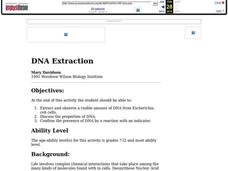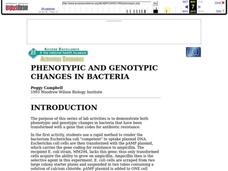Curated OER
Egg Toss
This cross curricular lesson involves eggs. Students read about eggs. A counting game involving an egg carton and ping pong balls (eggs) is played as students toss balls into numbered egg carton cups and adding their score. Students...
Curated OER
DNA Extraction
Students are able to extract and observe a visible amount of DNA from Escherichia coli cells. They discuss the properties of DNA. Students confirm the presence of DNA by a reaction with an indicator.
Curated OER
PHENOTYPIC AND GENOTYPIC CHANGES IN BACTERIA
Students use a rapid method to render the bacterium Escherichia coli "competent" in order to uptake plasmid DNA. They also have growth on the plain LB plates by the untransformed cells (which serve as controls). Students perform a cell...
Curated OER
Phenotypic and Genotypic Changes in Bacteria
Students investigate a rapid method to render the bacterium Escherichia coli "competent" to uptake plasmid DNA. They demonstrate the phenotypic changes associated with transformation. They perform a cell resuspension from the...
Curated OER
What Color is Your Colony?
Learners conduct an experiment to change the color of E. coli bacteria using genetic engineering. They work in small groups to add a plasmid containing a gene for red pigment to the bacteria and culture the bacteria to see if it ...
Curated OER
DNA Transformation of Bacteria-Ampicillin
Students demonstrate how genes can be transferred from one bacteria to another. In this experiment, they take a plasmid with a gene for resistance to the antibiotic ampicillin which is used to transfer the resistance gene into a...
Curated OER
Parts of a Chicken
In this chicken anatomy worksheet, students color and label 11 major parts of a chicken. There is a word bank to assist students.
Curated OER
The Puffin: The Clown of the Sea
In this comprehension activity, students complete multiple choice and fill in the blank questions about a video titled The Puffin: The Clown of the Sea. Students complete 37 problems total.
Curated OER
How Fragile Is an Egg?
Students design a "container" for his/her egg to determine whether the egg remain intact when dropped from a predetermined height.
Curated OER
DNA Profile Analysis
Students obtain a DNA sample, observe DNA Using Agarose Gel Electrophoresis, and obtain reagents and equipment.
Curated OER
The Egg and I
Students collect as much information as possible about their egg and record the information in a systematic way. They prepare a description of the egg your team was given that enable you to distinguish your egg from everyone else's egg.
Curated OER
More Time to Think
Students are responsible for their "egg baby" for two days. They may not leave the baby alone. The baby must be kept warm and safe at all times.
Curated OER
Disproving the Proof
Students investigate the progression of discoveries that have led to the genetics knowledge that scientists currently have. They determine how genetic experiments disproved previous theories on inheritance.
Curated OER
The Water Detectives
Learners collect water samples from designated sampling stations, and discuss water pollution. They analyze the water samples, record the data on a spreadsheet, and present the environmental water quality data to the class.
Curated OER
The Last Great Canal
Students read about a cholera outbreak in the 1840's. They read maps, predict how cholera moved throughout the country and participate in a lab activity that demonstrates how disease is spread. They compare cholera through time.
Curated OER
Baby Animals
Young scholars study baby penguins and whales. They name the penguin body parts and examine how penguins hatch from eggs. They name whale body parts and their function. They participate in a whale role play activity.
Curated OER
Science: Conditions for Slime Mold Survival
Young scholars perform experiments to determine the nutritional needs and physical space requirements for slime mold to survive. After formulating hypotheses, they seal the petri dishes and set up the experiment along with two controls....
Curated OER
Microbiology Lesson Plan Aseptic Technique
Pupils examine the importance of aseptic technique, become familiar with media plates, and general microbiology techniques. They study the benefits and dangers of bacteria and other microorganisms in their lives.
Curated OER
Designing for Salmon and Steelhead
Sixth graders create designs for salmon habitats. They work in groups to design a tank habitat that mimics the requirements for salmon in various phases of its life cycle. Students may also raise salmon eggs as part of this unit.
Curated OER
Experimenting with Yeast Metabolism
Ninth graders determine the rate of respiration by yeast and which sugars can be used as a food source by yeast using a CO2 gas sensor and computer software. This lesson is for an honors Biology class.
Curated OER
Sea Turtle Savvy
Young scholars explore sea turtles. They create paper plate sea turtles and brainstorm other organisms that live in the sea turtle's habitat. They role-play scenes from a nonfiction book, A Baby Sea Turtle's Journey. They play a game...
Curated OER
Mutations--Preexisting or Acquired?
Learners state the controls and variables of the Newcombe spread experiment. They state a hypothesis for the Newcombe spread experiment. Students distinguish between the characteristics of a preexisting mutations and those of an...
Curated OER
Chick Embryology
Students investigate techniques that can be used to observe the development of the chick embryo. They explore the environment in which the chick develops and how it can be manipulated.
Curated OER
Mutations--Preexisting or Acquired?
Students explore the reasoning and experimental approaches to mutations. They expose a culture of E. coli to virulent bacteriophage and observe whether mutations of the cells existed previously or if the bacteria mutated as a response...
Other popular searches
- Chicken Incubation
- Incubation of Chicken Eggs
- Egg Incubation
- Chicken Incubation Crossword
- Duck Incubation
- Incubation Observation
- Chick Incubation

























